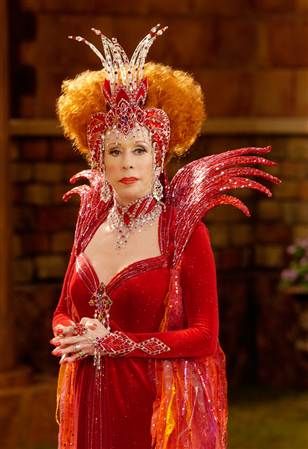 Carol Burnett is undeniably the unsung foremother of TV comedy. While Lucille Ball deserves praise galore for her groundbreaking 1950s sitcom, big-eyed, big-jawed, big-hearted, big-italics Burnett was one of the first women on TV to lead a regular variety hour. Emerging in the early 1960s as a star on Broadway and “The Garry Moore Show,” she signed a contract with CBS who tried to pigeonhole her into a sitcom. Instead she launched the smash “The Carol Burnett Show,” which lasted eleven seasons–a feat even now on network television–and helped make the careers of such golden girls as Vicki Lawrence and Bernadette Peters while resuscitating such secretly hilarious sirens as Shirley Temple and Rita Hayworth.
Carol Burnett is undeniably the unsung foremother of TV comedy. While Lucille Ball deserves praise galore for her groundbreaking 1950s sitcom, big-eyed, big-jawed, big-hearted, big-italics Burnett was one of the first women on TV to lead a regular variety hour. Emerging in the early 1960s as a star on Broadway and “The Garry Moore Show,” she signed a contract with CBS who tried to pigeonhole her into a sitcom. Instead she launched the smash “The Carol Burnett Show,” which lasted eleven seasons–a feat even now on network television–and helped make the careers of such golden girls as Vicki Lawrence and Bernadette Peters while resuscitating such secretly hilarious sirens as Shirley Temple and Rita Hayworth.
Now eighty-three, Burnett has written her third memoir, In Such Good Company, a tell-all about the show that entertained home audiences from 1967 to 1978. Stuffed with juicy tidbits about new and old Hollywood (you’ll adore tales of Carol Channing’s diet of whale blubber), the book is so frank and funny that it inspired me to hunt down some of the skits she describes so vividly.
“Went With the Wind”
Not everyone realizes hot-hot-hot ‘70s designer Bob Mackie was Burnett’s costumer, but his visual wit often put the cherry on Carol’s comedy stylings. He made her pencil skirts so skinny that they reinforced her hilariously awkward walks. He put pockets in all her dresses to accommodate her fear of what to do with her hands. And in this send-up of the Southern epic “Gone with the Wind,” Burnett plays Starlett O’Hara, whose famous dress fashioned from curtains grows, well, literal in Mackie’s hands. She writes, “When Bob brought out THE DRESS, I fell on the floor laughing … and the audience went crazy. It has been called one of the funniest moments in television history.” All told, Burnett reports, Mackie made sixty-five costumes for her a week – 17,940 costumes in total!
“In the Park”
One of the secrets to the show’s success was Burnett’s keen eye for other people’s talent. Not only did she give Vicki Lawrence her first shot (more on that in a bit) but she bumped the great Tim Conway up from a floating guest to a series regular. Of his real-life persona, she writes that he was “kind, considerate – and gloriously nutty,” and describes a party in which he spent the entire night on a couch “with his head wrapped in toilet paper.” He had a gift for ad-libs, she says, in which he would “keep upping the ante until the audience caught onto his joke and [other cast members struggled to] hold it together.” Here, in this classic bit in which he plays one of his many old man characters, Burnett pays him back with a few wicked improvs of her own.
“The Family”
When Carol discovered Vicki Lawrence, the younger woman was a teen-aged pageant star afraid of her own shadow. Unconvinced of her chops, the network tried to pressure Burnett to fire her. Instead, she and Conway cultivated the young woman until she developed the finesse to play Burnett’s mother in “The Family,” one of the show’s most famous – and controversial – running gags. As Mama, Lawrence played the Southern mother of the perpetually agitated “Eunice,” played by Burnett. The skit became so popular that eventually Lawrence landed the spinoff series “Mama.” But guess who didn’t like the skit? None other than Cary Grant. Burnett writes that “charming as ever,” the matinee idol told her how much he liked her series with “one reservation … I wish you wouldn’t do those ugly characters without any redeeming qualities!” Carol’s response? “There’s no accounting for taste.”
“Two Cleaning Ladies”
Burnett is admirably open about her struggles as a woman in charge, citing an unwillingness to cut weak sketches and jokes made at the expense of her own phsyicality lest she seem too domineering. She names Lucille Ball as a role model not only for her uproarious physical comedy but because of how she stood up for herself. “Lucy had a reputation for being tough when it came to her show,” she writes. “Tough could be a compliment when you were talking about a Milton Berle or a Jackie Gleason but back in the ‘60s it was just the opposite if you were talking about a woman in the same business.” Here, Ball joins Burnett in the latter woman’s “cleaning lady” bit – a sketch so iconic that a corresponding animation became the logo for the show.
This was originally published on Signature.
